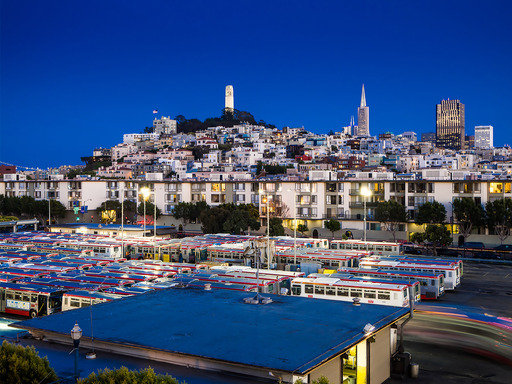I've been running my RAW source files through Lightroom CC's HDR Photo Merge and Google's HDR Efex Pro 2 to compare the differences. I have head to head examples to show you here.
 San Francisco Skyline - Image processed with 3 RAW source files in Lightroom CC. Photos by Derrick Story. Click on image for larger view. Also, you can see a better rendering of this image on the TDS Flickr page.
San Francisco Skyline - Image processed with 3 RAW source files in Lightroom CC. Photos by Derrick Story. Click on image for larger view. Also, you can see a better rendering of this image on the TDS Flickr page.
Lightroom's workflow is an all-RAW process. In other words, you start with your camera's RAW files, and the resulting merge is a DNG that you can process in the Develop module.
The advantage to this is that more quality is retained through post production. Take a look at the Lightroom version above. It has virtually no tell-tale edge glow on the skyline buildings, and the overall image is very clean.
 San Francisco Skyline - Image processed with 3 RAW source files in HDR Efex Pro 2. Photos by Derrick Story. Click on image for larger view.
San Francisco Skyline - Image processed with 3 RAW source files in HDR Efex Pro 2. Photos by Derrick Story. Click on image for larger view.
When I processed the same 3 source files in HDR Efex Pro 2, the resulting image was more dramatic. But it also included edge glow around the skyline buildings.
Now to keep things fair, remember that I made editing choices in both applications to reach the final result. But, in both cases, I was trying to produce the best photograph possible.
The opinion I'm developing about both of these applications is this: When I want a more "photographic" image, I'll use Lightroom CC for my HDR processing. I think the overall quality is higher, and there are fewer tell-tale HDR byproducts.
However, when I want pure drama, I think HDR Efex Pro 2 delivers the goods. And if necessary, I can clean up those tell-tale remnants in post.
Free Guide to Adobe HDR and Panoramas
Check out my free eBook, Rocky Nook's Guide to HDR and Panoramas with Photo Merge in Lightroom CC that shows you how to create beautiful HDRs and panoramas with the latest Adobe technologies.
Want to Comment on this Post?
You can share your thoughts at the TDS Facebook page, where I'll post this story for discussion.











